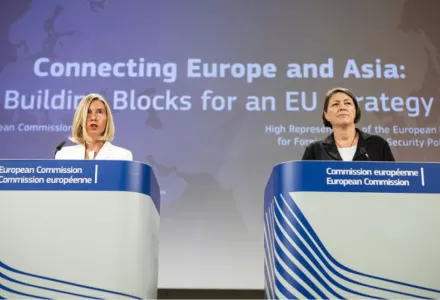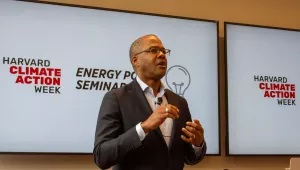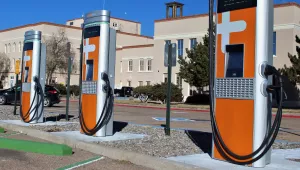
As part of the Project on Europe and the Transatlantic Relationship’s (PETR) event series, Ambassador Romana Vlahutin, Ambassador at Large for Connectivity in the European External Action Service, addressed the EU’s new Connectivity Strategy on Thursday April 18, 2019 in a conversation with Philippe Le Corre, PETR affiliate and senior fellow with Harvard Kennedy School's Mossavar-Rahmani Center on Business and Government at the Harvard Kennedy School.
“EU has connectivity in its genes, and has been doing massive work for decades inside its borders, but we now need to explain about the value we add to sustainable connectivity across the globe” she opened. Already, the Union was committed to “putting innovation and standards” at the core of its four-pillar strategy focused on increasing the linkages “created by transport, energy, digital and human connectivity.”
Innovation had to be at the core of all policies toward the goal of expanding Europe’s reach in its own neighborhood and to connecting new emerging markets. This could be achieved by creating greater opportunities for collaboration between the “worlds of science and policy.”
The EU strategy, she emphasized, was not oriented against any other power, alluding to Chinese engagement across the globe: the goal was to build connectivity for all, it is not an agenda against anyone but a positive agenda for something, and that something is sustainable connectivity.
“There is no connectivity solution that can work one power alone, no matter how big this power is,” she said.
She emphasized that a key enabling factor of this connectivity strategy will be to create a level playing field for businesses and infrastructure providers from all over the world.
China had been willing to take greater risks in creating global connectivity that supported its global interests.
“They were willing to take on un-bankable projects, that were needed by the recipient countries but at the same time brought strategic collateral to China. We need new instruments to ‘de-risk’ projects, too.”
Hence, the EU had developed a strategy that leveraged the strengths of existing multilateral financial institution to the table. The European Investment Bank, the World Bank or the EBRD will also have an important role role to play in the financing of the projects, together with private investors, she said.
China’s First-Mover Advantage?
China saw a great need for investment in infrastructure, they acted fast, providing a quick response to these countries without imposing a large bureaucratic burden.
The EU would have to upgrade its pacing in the implementation phase of its connectivity strategy: “EU brings state-of-the-art standards and norms, quality of infrastructure investment and sustainability in economic, financial, environmental and social terms. There are many countries very eager to have the EU at the table providing a viable alternative, but we need to change our pace – we need to step up our game,” she said.
“This is not about China, this is about us, and how we understand and prepare for the challenges of the future” she said.”
Despite all of the nuanced criticism of China’s seemingly interest-driven global engagement, she noted that the country had “provided global public goods, funding projects that others would not have undertaken.” However, she also expressed reservations about the way the Belt and Road initiative had been pursued, in particular from a sustainability perspective. She questioned the longer term consequences on the countries receiving the infrastructure investments. “It is important to have red lines with respect to our values,” she said pointing to the fact that European connectivity projects would always bear the hallmark EU standards.
Lecomte, Carole. “Ambassador Romana Vlahutin: The EU's Connectivity Strategy.” May 10, 2019




